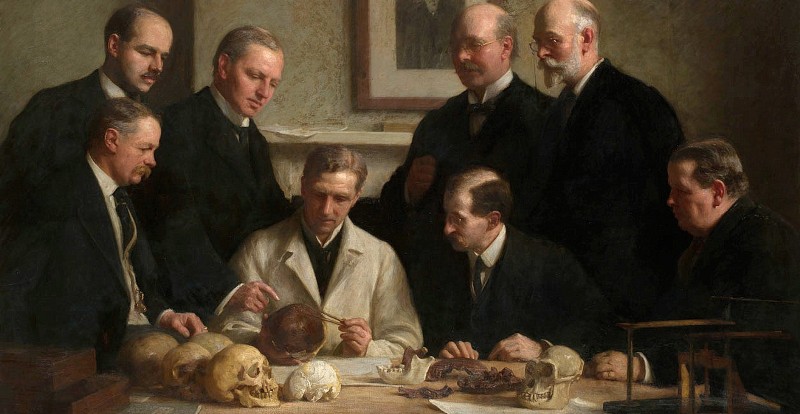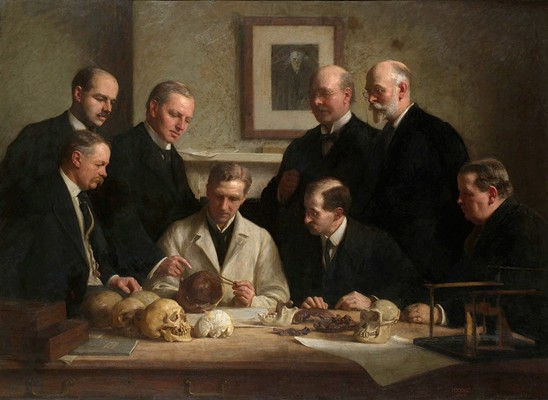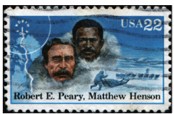
Think about the following questions.
1. What is the most recent scientific discovery that you found interesting or exciting?
2. How does the theory of evolution explain human ancestry?
3. Have you heard of the phrase “the missing link”? What do you think it refers to?
VOCABULARY PREVIEW
Match each New Academic Word List(NAWL) word with the correct definition.
- fossil _____
- sensation _____
- credibility _____
- prominent _____
- plausible _____
- criterion (pl. criteria) _____
- a. standard(s) for judging or categorization
- b. the extremely old remains of a living thing
- c. a cause of excitement and interest
- d. well-known and distinguished
- e. reasonable; possible by logic
- f. characteristic of trustworthiness, authority, or believability
THE PILTDOWN MAN

One of the most famous (or infamous) frauds in the history of science is known as the Piltdown Man, the remains of a supposed primitive hominid1 found in 1912 by an amateur paleontologist2 named Charles Dawson and a professional paleontologist named Arthur Smith Woodward. In fact, two such sets of fossils were discovered between the years 1912 and 1915. The first was found in the Piltdown gravel pit3 in Sussex, England. While digging in the pit, the paleontologists found a humanlike skull with a jawbone similar to that of an ape. This finding appeared to be the remains of a "missing link," the evolutionary step that connects apes and humans. The discoverers named the remains Eoanthropus dawsoni, or "Dawson's Dawn Man," but the find later became known as the Piltdown Man due to the location of its discovery.
The Piltdown Man was an immediate sensation. He seemed to fit all of the criteria expected in the missing link-a mixture of human and ape with the noble brow of Homo sapiens and a primitive jaw. Best of all, he was British! However, the reactions to the findings were mixed. On the whole, British paleontologists were enthusiastic, but French and American paleontologists tended to be skeptical of the origins of the Piltdown Man. Some objected to its credibility quite vociferously4. The objectors held that the jawbone and the skull were obviously from two different animals, and the fact they were discovered together was simply an accident of placement. At first, fraud wasn't suspected. After all, Dawson and Woodward had no expectation of financial gain from the discovery. In addition, there had been other European finds related to the missing links of modern-day man, such as the Neanderthal, Cro-Magnon Man, and Heidelberg Man. So the existence of another "missing link" in the history of man's evolution was not so surprising to some researchers.
However, some investigators remained doubtful of the origins of the Piltdown Man, continuing to express strong doubt that the skull and the jaw were from the same species. The perpetrators5 of the hoax6 solved this problem by planting a second jaw and a second skull at another nearby location. The subsequent report in 1915 of the discovery of "Piltdown Man II" converted many of the skeptics. Their reasoning was that one accident of placement was plausible, but two were not. So after this second finding, most of the doubters were satisfied. Moreover, some prominent British scientists failed to perform tests that they should have done and obstructed other scientists' access to the fossils. Some historians believe that the discoverers of the Piltdown Man and these scientists may have been co-conspirators7 in the hoax.
The fame of the Piltdown Man continued for forty years. It was featured in professional articles and books, in newspaper reports, and even in high-school biology textbooks. In the decades from 1915 to 1950, there was, of course, some opposition from scientific critics who claimed that the skull was human, but the jaw was that of an ape.
During the 1950s, the validity of the Piltdown Man discovery was questioned further. Several researchers concluded that almost all, if not all, of the fossils had been planted in the pit in modern times and that several of these items had even been fabricated8. These scientific detectives, among them Joseph Weiner and Kenneth Oakley, discredited the Piltdown Man fossils with technical evidence showing that the skull belonged to an English woman and the jaw to an Asian orangutan. Chemical tests in 1953 further proved that everything was, in fact, fake. The discovered pieces had been stained, filed, smashed, and so on, in a clever way, thus leading people to initially believe that the Piltdown Man was real.
The question still remains: Who did it? Even though it has been over a century since the discovery of the Piltdown Man, there is still no certainty about who managed one of the greatest hoaxes in the history of science.
New Academic Word List
- hominid 1 : n. a member of the family of humans
- paleontologist 2 : n. a scientist who studies ancient life forms
- gravel pit3 : n. a place where small, rounded stones are dug out of the ground
- vociferously4 : adv. loudly; with strong emotion
- perpetrator 5 : n. a person who commits an act that is illegal or wrong
- hoax 6 : n. something accepted or established by fraud or fabrication
- co-conspirator 7 : n. a person who schemes with another
- fabricate8 : v. to make up (a story or lie)
READING COMPREHENSION
A ‣ Mark each statement as true (T) or false (F) according to the reading.
- Most British experts immediately doubted that the skull was real.
- True
- False
- Dawson and Woodward made a lot of money from their discovery.
- True
- False
- Neanderthal remains were found before the Piltdown Man remains.
- True
- False
- Many people believed for several decades that the Piltdown Man was real.
- True
- False
- Charles Dawson was finally identified as the perpetrator.
- True
- False
B ‣ Choose the best answer according to the reading.
- What is the main purpose of the reading?
- a. To clarify a misunderstood and criticized scientific find
- b. To argue that science is full of fraud and dishonesty
- c. To explain how a hoax was perpetrated and then discovered
- d. To compare early and contemporary paleontological methods
- What is paragraph 2 mainly about?
- a. The motives of the perpetrators
- b. Contemporary paleontological finds
- c. National rivalries between paleontologists
- d. Initial reactions toward the Piltdown discovery
- Which fact made some skeptics change their minds?
- a. A second set of remains was found.
- b. Many books were written about the "missing link."
- c. Scientists chemically tested the bones.
- d. Scientists in other countries believed the hoax.
- The word it in paragraph 6 refers to _____.
- a. something people believed
- b. the hoax that was perpetrated
- c. evidence that was destroyed
- d. proof that the skull was faked
C ‣ Fill in the blanks with information from the reading.
- Charles Dawson was one of the paleontologists who claimed to have found the remains of a(n) _____ .
- While the jawbone was similar to that of an ape, the skull was _____ .
- The _____ of the Piltdown discovery came under further question in the 1950s.
SUMMARY
Fill in the blanks with the phrases in the box.
- convinced skeptics
- suspect fraud
- been fabricated
- the missing link
- tampered with
- the same species
|
Discovery
|
|
Doubt
|
|
Debunking
|
VOCABULARY PRACTICE
Fill in the blanks with the words in the box. Change the form if necessary.
- credibility
- criteria
- fossil
- plausible
- prominent
- sensation
- The famous scientist lost all _____ once his fabricated data came to light.
- Some _____ are actually impressions of an animal left in mud that later turned to stone.
- Although we do not have the technology currently, many scientists agree that colonization of Mars is _____ .
- It's hard for the younger generation to imagine what a _____ CDs caused when they first came out.
- Many _____ scientists like Neil deGrasse Tyson have gone on record saying that the anti-GMO movement has no scientific merit.
- Some paleontologists now question the _____ by which dinosaurs were originally classified as cold-blooded.
SUPPLEMENTAL READING
The First to the North Pole

The Piltdown Man hoax is not unique in the history of science. The exploration of the North Pole includes another case of this nature. The two main players in this story are Robert Peary, a famous explorer in the early 20th century, and Dr. Frederick Cook, another explorer who frequently accompanied Peary on his expeditions.
Both men began their own quests to reach the North Pole in the early 1900s. However, the question of who reached the North Pole first, if either, remains hotly debated. According to Dr. Cook, he reached the pole on April 21, 1908. His claim is recorded in his diary: "With a step, it was possible to go from one part of the globe to the opposite side... North, east, and west had vanished. It was south in every direction." Cook then became lost in the Arctic for almost a year.
Meanwhile, Peary was also trying to reach the North Pole. He claimed to have arrived there on April 6, 1909, almost a year after Cook. However, Peary believed Cook had never made it to the Pole and had, in fact, died trying to reach it. This led Peary to believe that he was the first to reach the Pole. In September 1909, both men managed to make it back to civilization alive and well and, within days of each other, telegraphed their rival claims to the newspapers.
Controversy ensued when Peary accused Cook of fraud, claiming that he had no compelling evidence to support his claim. In fact, the controversy lingers to this day. Who was the first man to reach the North Pole? For many years, Peary's supporters, backed by National Geographic magazine, had the upper hand. However, new evidence suggests that both explorers faked their claims. In other words, neither of them reached the Pole, which would put later explorers in line for the title of "first to reach the North Pole."
Fill in the blanks with information from the reading.
- Dr. Frederick Cook frequently went on expeditions with _____ .
- Peary mistakenly thought that Cook _____ .
- New evidence suggests neither man actually _____ .

Leave a comment
Load more